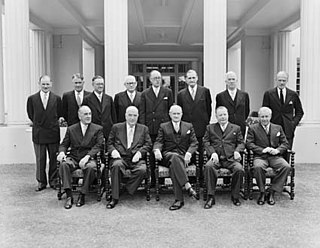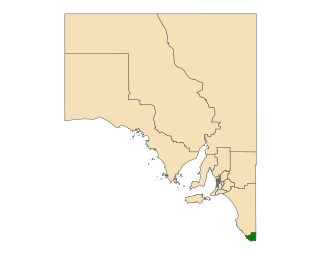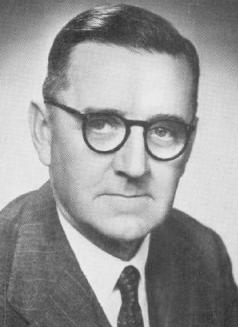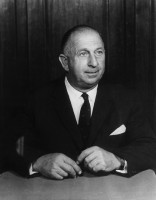Related Research Articles

The Liberal Party of Australia is a centre-right political party in Australia. It is one of the two major parties in Australian politics, the other being the Australian Labor Party. The Liberal Party was founded in 1944 as the successor to the United Australia Party. Historically the most successful political party in Australia’s history, the Liberal Party is now in opposition at a federal level, although it presently holds government in Tasmania and the Northern Territory at a sub-national level.

The Liberal–National Coalition, commonly known simply as the Coalition or the LNP, is an alliance of centre-right to right-wing political parties that forms one of the two major groupings in Australian federal politics. The two partners in the Coalition are the Liberal Party of Australia and the National Party of Australia. Its main opponent is the Australian Labor Party (ALP); the two forces are often regarded as operating in a two-party system. The Coalition was last in government from 2013 to 2022. The group is led by Peter Dutton, who succeeded Scott Morrison after the 2022 federal election.

The Seventh Menzies ministry was the 37th ministry of the Government of Australia. It was led by the country's 12th Prime Minister, Robert Menzies. The Seventh Menzies ministry succeeded the Sixth Menzies ministry, which dissolved on 11 January 1956 following the federal election that took place in the previous December. It is the first ministry to consist of a two-tier ministry, with only senior ministers being members of Cabinet, while the other ministers are in the outer ministry. With the exception of the Whitlam government and the caretaker First Fraser ministry, this practice has endured to this day. The ministry was replaced by the Eighth Menzies ministry on 10 December 1958 following the 1958 federal election.

The Eighth Menzies ministry was the 38th ministry of the Government of Australia. It was led by Prime Minister Robert Menzies. The Eighth Menzies ministry succeeded the Seventh Menzies ministry, which dissolved on 10 December 1958 following the federal election that took place in late November. The ministry was replaced by the Ninth Menzies ministry on 22 December 1961 following the 1961 federal election.
This is a list of members of the Australian House of Representatives from 1958 to 1961, as elected at the 1958 federal election.

Port Macquarie is an electoral district of the Legislative Assembly in the Australian state of New South Wales. It is represented by Leslie Williams of the Liberal Party.

Mount Gambier is a single-member electoral district for the South Australian House of Assembly. It covers the far south-east corner of the state containing the City of Mount Gambier and District Council of Grant local government areas. It is centred on the city and extinct volcano of Mount Gambier.

The 1958 Australian federal election was held in Australia on 22 November 1958. All 122 seats in the House of Representatives and 32 of the 60 seats in the Senate were up for election. The incumbent Liberal–Country coalition led by Prime Minister Robert Menzies defeated the opposition Labor Party, led by H. V. Evatt.

The 1955 Australian federal election was held in Australia on 10 December 1955. All 122 seats in the House of Representatives and 30 of the 60 seats in the Senate were up for election. An early election was called to bring the House and Senate elections back in line; the previous election in 1954 had been House-only. The incumbent Liberal–Country coalition led by Prime Minister Robert Menzies increased its majority over the opposition Labor Party, led by H. V. Evatt.
An election was held on 21 November 1970 to elect 32 of the 60 seats in the Australian Senate. This is the most recent occasion on which a Senate election has been held with no accompanying election to the House of Representatives; the two election cycles had been out of synchronisation since 1963.

Sir Philip Albert Martin McBride, was an Australian politician. He was a United Australia Party member of the Australian House of Representatives for Grey from 1931 to 1937 and the Australian Senate from 1937 to 1944, and a Liberal Party of Australia member of the House of Representatives for Wakefield from 1946 to 1958. He served as a minister in both of Robert Menzies' governments, as Minister for the Army and Minister for Repatriation (1940), Minister for Supply and Development and Minister for Munitions (1940–1941), Minister for the Interior (1949–1950), and Minister for Defence (1950–1958).
This is a list of the members of the Australian House of Representatives in the 22nd Australian Parliament, which was elected at the 1955 election on 10 December 1955. Three new seats were created and two were abolished. The incumbent Liberal Party of Australia led by Prime Minister of Australia Robert Menzies with coalition partner the Country Party led by Arthur Fadden won an additional eleven seats, defeating the Australian Labor Party led by Herbert Evatt, which lost ten seats.
This is a list of members of the Australian Senate from 1962 to 1965. Half of its members were elected at the 22 November 1958 election and had terms starting on 1 July 1959 and finishing on 30 June 1965; the other half were elected at the 9 December 1961 election and had terms starting on 1 July 1962 and finishing on 30 June 1968. The process for filling casual vacancies was complex. While senators were elected for a six-year term, people appointed to a casual vacancy only held office until the earlier of the next election for the House of Representatives or the Senate.
This is a list of members of the Australian Senate from 1959 to 1962. Half of its members were elected at the 10 December 1955 election and had terms starting on 1 July 1956 and finishing on 30 June 1962; the other half were elected at the 22 November 1958 election and had terms starting on 1 July 1959 and finishing on 30 June 1965. The process for filling casual vacancies was complex. While senators were elected for a six-year term, people appointed to a casual vacancy only held office until the earlier of the next election for the House of Representatives or the Senate.
This is a list of members of the Australian Senate from 1956 to 1959. Half of its members were elected at the 9 May 1953 election and had terms starting on 1 July 1953 and finishing on 30 June 1959; the other half were elected at the 10 December 1955 election and had terms starting on 1 July 1956 and finishing on 30 June 1962. The process for filling casual vacancies was complex. While senators were elected for a six-year term, people appointed to a casual vacancy only held office until the earlier of the next election for the House of Representatives or the Senate.
This is a list of members of the Tasmanian House of Assembly between the 13 October 1956 election and the 2 May 1959 election. The previous Darwin division had been renamed Braddon after former Premier of Tasmania Sir Edward Braddon.

Kimberley Arthur Wells is an Australian politician. He has been a Liberal member of the Victorian Legislative Assembly since 1992, representing first Wantirna and then Scoresby and Rowville. Wells was the Treasurer of Victoria from December 2010 until March 2013. Wells was born in Leongatha, Victoria, and attended public schools in Bairnsdale, graduating in 1976.

Elections were held in the Australian state of Queensland on 28 May 1960 to elect the 78 members of the state's Legislative Assembly. The election followed the enactment of the Electoral Districts Act 1958 which increased the Assembly from 75 to 78 seats and modified the zonal system first established by Labor ahead of the 1950 election.

Elections were held in the Australian state of Victoria on Saturday 31 May 1958 to elect the 66 members of the state's Legislative Assembly. This was the last time Assembly elections were held separately from those for the Legislative Council.

The 1955 Victorian state election was held in the Australian State of Victoria on Saturday, 28 May 1955 to elect 65 members of the state's Legislative Assembly.
References
- ↑ "By-Elections 1955-1958". Psephos.